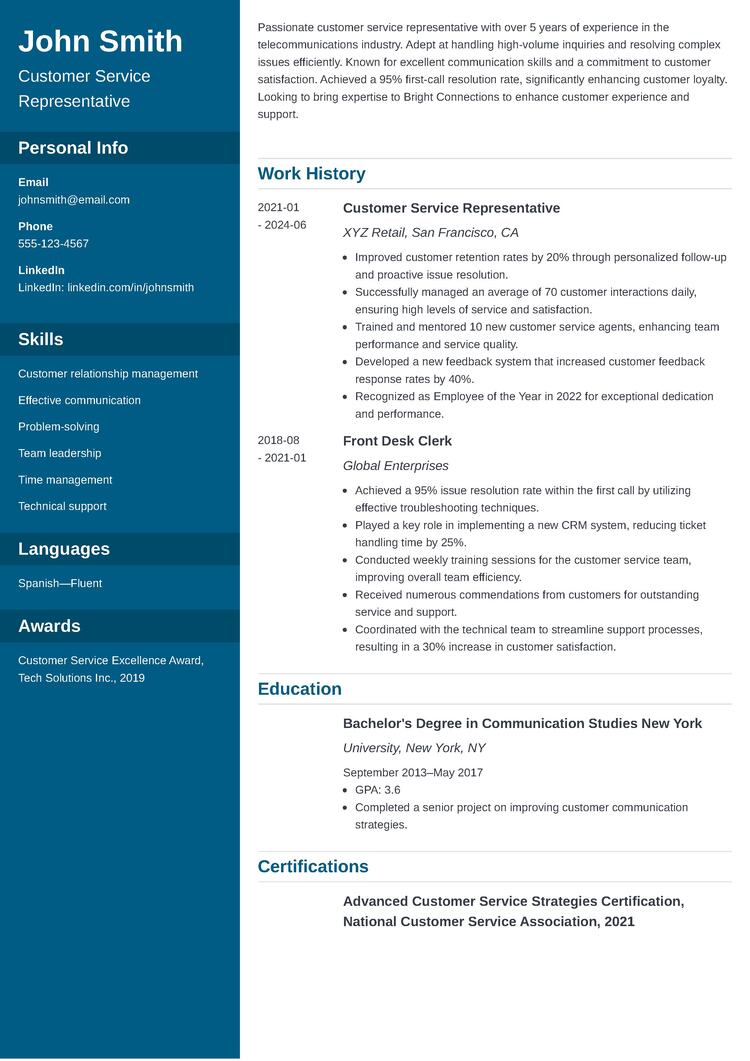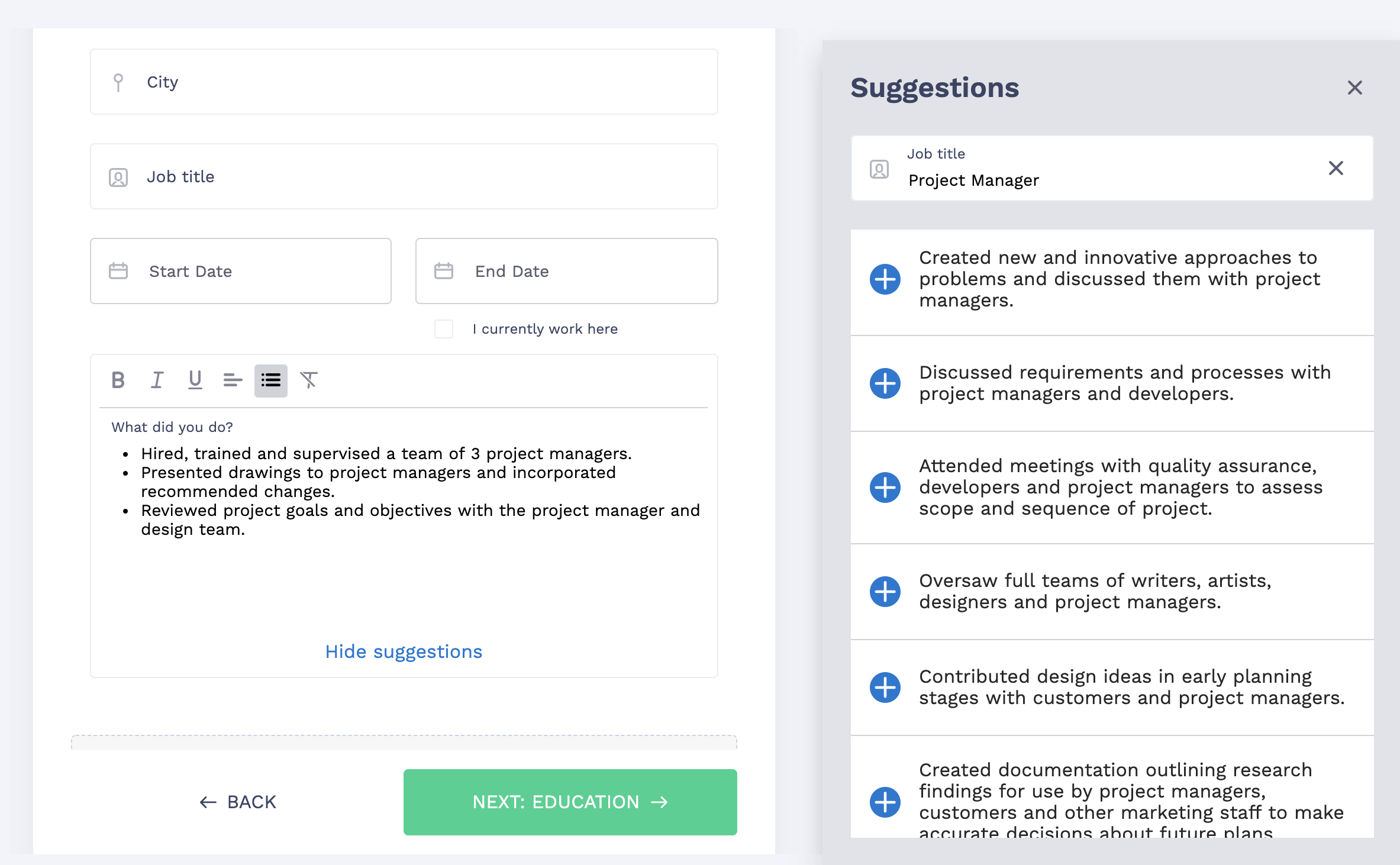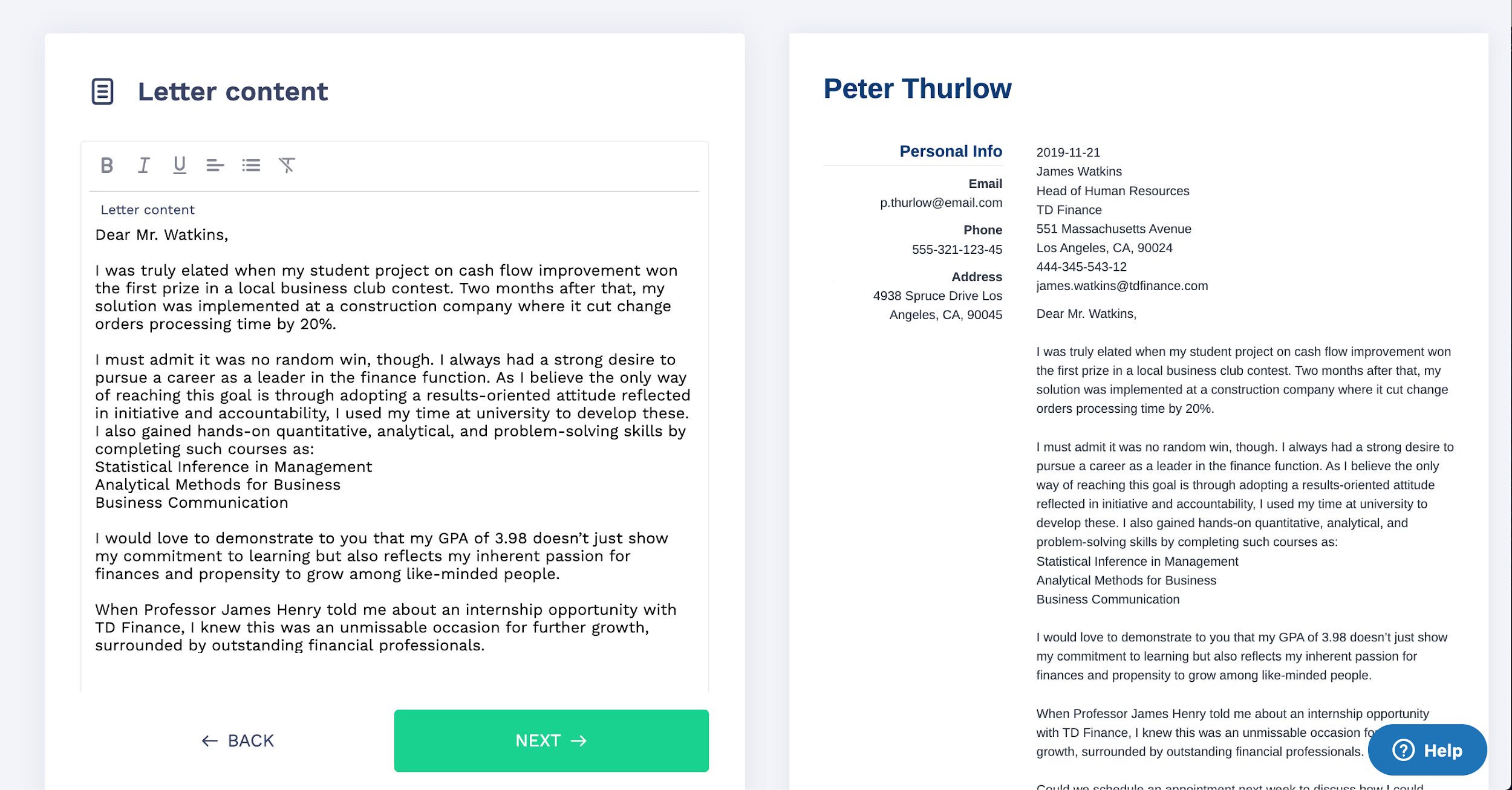
Customer Service Resume Examples With Skills for 2026
Get the customer service job you’ve always wanted with an impactful customer service resume. Here’s how to get a consistently high recruiter satisfaction rate.

Olga Ber
Career Expert

Whether starting a career in customer service or staying updated on trends, this article offers key insights to guide your career decisions and understanding of the field.
In 2024, the customer service field doesn’t stop changing, and staying ahead of the curve can make all the difference in landing your dream role. Knowing the latest trends and stats might be a game-changer if you’re on the hunt for a job in this field.
I’ve compiled the most impactful customer service statistics for 2024 so you can understand what’s hot & what’s not and tailor your job search and skills accordingly. Let’s dive into the numbers and discover what it takes to succeed in customer service this year!
Save hours of work and get a job-winning resume like this. Try our resume builder with 20+ resume templates and create your resume now.

What users say about ResumeLab:
I had an interview yesterday and the first thing they said on the phone was: “Wow! I love your resume.”
Patrick
I love the variety of templates. Good job guys, keep up the good work!
Dylan
My previous resume was really weak and I used to spend hours adjusting it in Word. Now, I can introduce any changes within minutes. Absolutely wonderful!
George
If you're considering a career in customer service, understanding the current workforce composition is essential. These facts from customer service research, with insights into gender distribution, age ranges, and primary employment sectors, might help you gauge where you might fit in the industry.
For 2023-2024, the workforce of customer service representatives in the U.S. is around 3.0 million people, maintaining a similar level compared to 2022. The gender distribution has shifted slightly, with approximately 69% of customer service representatives being women and 31% men, reflecting an increase in the proportion of female workers compared to the previous year's data.
Source: U.S. Bureau of Labor Statistics
This customer service fact shows a gender imbalance in the industry, which may be relevant for diversity initiatives or for understanding workplace dynamics.
Source: Zippia
The customer service field gathers both experienced professionals and younger workers, indicating opportunities for both entry-level positions and career advancement.
Source: Zippia
While a degree can be beneficial, it's not required for entry-level jobs in this field, making customer service an accessible career option for many.
Source: U.S. Bureau of Labor Statistics
Customer service statistics show that large companies may attract customer service reps due to more structured work environments and the potential for career growth.
Source: Zippia
This breakdown might help understand where to focus your job search efforts across different sectors.
Source: Zippia
If you’re considering a customer service job, note that these industries have the highest demand.
Source: Zippia
Job stability is a key consideration for many. The customer service field is known for a high turnover, though customer service reps are happy with their jobs. Below, we’re giving some insight into typical tenure lengths and turnover rates in customer service roles for a realistic view of career longevity in the field.
This high percentage of new hires suggests frequent job openings and opportunities for entry-level positions.
Source: Zippia
Customer service research shows that 70% of reps have been in their roles for 2 years or less, meaning high turnover but also frequent opportunities for new positions.
Source: Zippia
Such a low percentage of long-term employees might indicate challenges in retention or limited opportunities for long-term career growth within the same role.
Source: Zippia
This rate, while significant, suggests that customer service skills remain in demand even during challenging economic times.
Source: Zippia
Customer service job statistics show a relatively high job satisfaction rate, which might be encouraging for those considering a career in customer service.
Source: Knowmax
The below figures show projected growth, in-demand skills, and emerging trends, allowing you to align your career path with the industry's direction.
While this projection shows a slight decline, it's important to note that customer service skills remain valuable across many industries.
Source: U.S. Bureau of Labor Statistics
The high number of annual openings shows that there will still be significant job opportunities in the field, likely due to turnover and retirement.
Source: U.S. Bureau of Labor Statistics
Even though new technologies emerge rapidly, traditional communication remains important.
Source: Knowmax
The preference for phone communication in complex situations highlights the importance of strong verbal communication skills in customer service roles.
Source: Knowmax
Customer service data shows that jobseekers should focus on developing and highlighting these key customer service skills to increase their employability in the field.
Source: Knowmax
Understanding the day-to-day realities of customer service work is vital for jobseekers. The statistics below shed some light on common challenges faced by professionals and the priorities shaping the industry.
This highlights the fast-paced nature of customer service work and the importance of time management skills.
Source: Knowmax
The balance between efficiency and effectiveness is crucial for success in customer service roles.
Source: Knowmax
This indicates a trend towards more proactive and innovative customer service strategies, suggesting that creativity and problem-solving skills are increasingly valuable.
Source: Kaizo
This emphasizes the growing importance of customer experience, indicating that skills in this area will be highly valued.
Source: Kaizo
This customer service job statistic further underlines the critical role that customer service plays in a company's overall success.
Source: Kaizo
If you are considering a career as a customer service professional, understanding client expectations is a must. We've gathered insights into current customer preferences and expectations to help you meet the standards required in this role.
It highlights the need for adaptability and continuous learning in customer service roles.
Source: Kaizo
This shows a trend towards more proactive customer service, particularly in areas related to security and fraud prevention.
Source: Kaizo
This statistic further reinforces the value of proactive customer service strategies.
Source: Kaizo
Customer service research highlights the importance of timely responses, particularly on social media platforms.
Source: Knowmax
The ResumeLab builder is more than looks. Get specific content to boost your chances of getting the job. Add job descriptions, bullet points, and skills. Easy. Improve your resume in our resume builder now.

Nail it all with a splash of color, choose a clean font, and highlight your skills in just a few clicks. You're the perfect candidate, and we'll prove it. Use our resume builder now.
While the digital transformation of customer service continues to evolve, traditional communication remains important. The statistics below provide information on the technologies and communication channels you'll likely encounter in your future role, highlighting areas where you may want to develop your skills.
This trend towards self-service solutions indicates that customer service roles may evolve to focus more on complex issues and relationship building, while also highlighting the importance of providing effective self-service options.
Source: AmplifAI
Email remains a crucial communication channel in customer service, emphasizing the need for strong written communication skills.
Source: Kaizo
Despite the rise of digital channels, phone skills remain highly relevant in customer service roles.
Source: Kaizo
While still a minority, the use of video calls is growing, suggesting a potential area for skill development.
Source: Kaizo
This relatively low percentage indicates an area of potential growth in customer service strategies.
Source: Kaizo
This high percentage underscores the importance of social media skills in modern customer service roles.
Source: Knowmax
Social media's role in customer service is growing, creating opportunities for specialization for those with strong social media skills.
This emphasizes the importance of quick response times on social media platforms.
Source: Knowmax
This highlights the potential for social media interactions to improve brand perception.
Source:Knowmax
This customer service statistic demonstrates the direct impact that effective social media customer service can have on sales.
Source: Knowmax
Understanding how current customer service professionals view their roles can help you set realistic expectations. The customer service job statistics below offer a glimpse into job satisfaction and organizational culture within the industry.
This suggests a strong correlation between company culture and employee satisfaction in
customer service roles.
Source: Knowmax
This high percentage indicates that many customer service professionals find meaning in their work, which can contribute to job satisfaction.
Source: Knowmax
Customer service roles are generally perceived as meaningful and significant by those in the field.
Source: Knowmax
Many organizations recognize the crucial role that customer service representatives play in shaping customer relationships.
Source: Knowmax
Ultimately, success in customer service is measured by client satisfaction. These numbers provide context on industry performance, helping you understand the benchmarks you'll be working towards in your future role.
This trend towards self-service solutions suggests that customer service roles may evolve to focus more on complex issues and relationship building.
Source: AmplifAI
Transparency alone may not be sufficient for positive brand perception, highlighting the multifaceted nature of customer service.
Source: Knowmax
For forward-thinking jobseekers, knowing where companies are investing can inform their career decisions. Below, you’ll see customer service data focused on the key areas of development in customer service for a more successful job search strategy.
Jobseekers should be prepared to work alongside AI and automated systems, focusing on tasks that require human empathy and complex problem-solving.
This trend suggests that versatility across different communication channels will be increasingly valuable in customer service roles.
Source: Kaizo
This trend highlights the importance of developing skills in data interpretation and personalized communication.
The shift towards proactive service may require customer service professionals to develop skills in data analysis and predictive problem-solving.
Source: Kaizo
Customer service needs vary across sectors. Below, you can see how customer service roles are distributed across different industries, helping you target your job search to sectors that align with your interests and skills.
This makes retail one of the largest employers in the customer service field, offering numerous job opportunities.
Source: Zippia
Finance is another significant employer in customer service, often offering roles that require specialized knowledge.
Source: Zippia
There are many opportunities in large, established companies, which may offer more structured career paths and benefits.
Source: Zippia
While not the largest employer, the tech sector often offers customer service roles that require technical knowledge and may provide opportunities for career growth in tech-related fields.
Source: Zippia
While government jobs are less common in customer service, they may offer unique benefits and stability for those interested in public sector work.
Source: Zippia
If you’re a jobseeker oriented toward a customer service-related role, make sure that you stay informed about the latest customer service trends and statistics. We hope that the insights above will help you tailor your job search and skill development to meet industry demands.
Double your impact with a matching resume and cover letter combo. Use our cover letter generator and make your application documents pop out.

Want to try a different look? There's 21 more. A single click will give your document a total makeover. Pick a cover letter template here.
Do you have any questions about customer service job statistics for 2024 or additional insights to share? Leave a comment below—we'd love to hear from you!
At ResumeLab, quality is at the crux of our values, supporting our commitment to delivering top-notch career resources. The editorial team of career experts carefully reviews every article in accordance with editorial guidelines, ensuring the high quality and reliability of our content. We actively conduct original research, shedding light on the job market's intricacies and earning recognition from numerous influential news outlets. Our dedication to delivering expert career advice attracts millions of readers to our blog each year.

Get the customer service job you’ve always wanted with an impactful customer service resume. Here’s how to get a consistently high recruiter satisfaction rate.

Olga Ber
Career Expert

Scoring 97% in NPS is something you're good at. It's time to score 100% in the recruitment process. Check our guide and learn how to master your customer service manager resume.

Paulina Krolikowska-Baum
Managing Editor, Career Expert

Good customer service skills are useful in many professions. Learn how to add customer service skills to a resume, and which elements of customer service really matter.

Roma Konczak, CPRW
Certified Professional Resume Writer, Career Expert